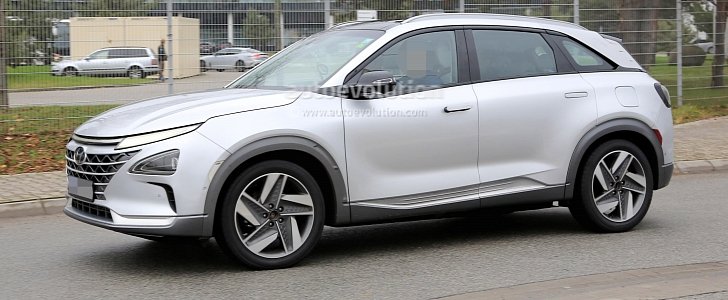The Tucson FCEV is long in the tooth, and in terms of range, it’s outperformed by more modern fuel-cell vehicles such as the Toyota Mirai and Honda Clarity. Come 2018, the FCEV Concept will turn to production reality with an estimated range of 800 kilometers (497 miles; NEDC).
That’s extremely impressive considering the Tucson FCEV, which has a 5.64-kilogram hydrogen storage tank and is called ix35 Fuel Cell in the Old Continent, is rated 594 kilometers (369 miles) on the New European Driving Cycle. Something else we know from the near-production concept presented earlier this year is the 20-percent more vigorous powertrain.
20 percent of 136 PS equals 27, so you’re looking at 163 PS (161 horsepower) from the electric motor of the production-ready FCEV. In regard to torque, 300 Nm plus 60 translates to 360 Nm, which converts to 266 pound-feet according to the imperial system of measurement. To be fair, the compact-sized FCEV definitely needs the extra determination.
Slotted above the Kona and below the Tucson, the FCEV Concept will be given an actual name in January 2018 at the Consumer Electronics Show. The yet-to-be-baptized model features Kona-inspired styling up front, retractable door handles, and clear taillights at the rear. Also at the rear, the hatchback liftgate is as square as it gets, easing access to the trunk.
In a similar fashion to the Tucson FCEV/ix35 Fuel Cell, the next-generation FCEV flaunts the filler cap door on the left-hand rear quarter panel. By comparison, the Kona EV that’s also scheduled to debut in 2018 has the charging port door located up front, right next to the left headlight.
The Hyundai Motor Company intends to launch 28 green vehicles by the end of 2020, and when it comes to fuel-cell technology, the South Korean automaker will debut a second FCEV by decade’s end. Eight battery-powered EVs, eight plug-in hybrid vehicles, and 10 hybrid vehicles are also confirmed, which is a tremendous pledge whichever way you look at Hyundai's near-future roadmap.
20 percent of 136 PS equals 27, so you’re looking at 163 PS (161 horsepower) from the electric motor of the production-ready FCEV. In regard to torque, 300 Nm plus 60 translates to 360 Nm, which converts to 266 pound-feet according to the imperial system of measurement. To be fair, the compact-sized FCEV definitely needs the extra determination.
Slotted above the Kona and below the Tucson, the FCEV Concept will be given an actual name in January 2018 at the Consumer Electronics Show. The yet-to-be-baptized model features Kona-inspired styling up front, retractable door handles, and clear taillights at the rear. Also at the rear, the hatchback liftgate is as square as it gets, easing access to the trunk.
In a similar fashion to the Tucson FCEV/ix35 Fuel Cell, the next-generation FCEV flaunts the filler cap door on the left-hand rear quarter panel. By comparison, the Kona EV that’s also scheduled to debut in 2018 has the charging port door located up front, right next to the left headlight.
The Hyundai Motor Company intends to launch 28 green vehicles by the end of 2020, and when it comes to fuel-cell technology, the South Korean automaker will debut a second FCEV by decade’s end. Eight battery-powered EVs, eight plug-in hybrid vehicles, and 10 hybrid vehicles are also confirmed, which is a tremendous pledge whichever way you look at Hyundai's near-future roadmap.





















